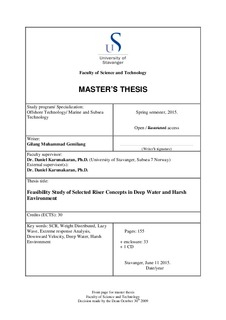| dc.contributor.author | Gemilang, Gilang M. | |
| dc.date.accessioned | 2015-09-29T08:43:19Z | |
| dc.date.available | 2015-09-29T08:43:19Z | |
| dc.date.issued | 2015-06-11 | |
| dc.identifier.uri | http://hdl.handle.net/11250/302432 | |
| dc.description | Master's thesis in Offshore technology | nb_NO |
| dc.description.abstract | Todays, oil and gas sources are explored in deep water and harsh environment. A riser system is one of the major sub-facilities to transfer oil and gas from the seabed to the host platform. One of the well-known riser systems, the Steel Catenary Riser (SCR), has been an attractive choice for the riser system in deep water. However, the main challenge of the SCR is large motions from the host platforms due to the harsh environment. The large motion of host platforms may induce excessive buckling and fatigue at the touchdown point. The key component of the large motion of the host platform is the downward velocity at the hang-off point where the top-end of the riser is attached to the host platform.
By screening the downward velocities at the hang-off point in the time history graph, the time at which the critical responses (i.e. buckling utilization, bending moment and compression) peak is identified. This study investigates the feasibility of the SCR configuration in terms of the capability to cope with the vessel motion. Several types of the SCR configurations are proposed in this study. The selected configurations of SCR in this study are conventional SCR, Weight Distributed SCR (WDSCR), and Steel Lazy Wave Riser (SLWR). The feasibility of the three riser configurations was analyzed in terms of strength and fatigue performance to understand the limitation of one over the other. The strength assessment of the risers was performed by using load cases, the screening approach was based on different extreme downward velocities at the hang-off point. The checks were according to DNV.
The fatigue performance of the risers was checked considering both wave-induced fatigue and fatigue due to vortex induced vibration. Overall, from the extreme response analysis study, results showed that a feasible conventional SCR configuration can be obtained if the downward velocity at the hang-off point is restricted below 2.6 m/s. It is also found that the downward velocity at the sag-bend of the conventional SCR is restricted below 3.03 m/s. On the other hand, a feasible WDSCR configuration can be obtained, if the downward velocity at the hang-off point is restricted below 3.2 m/s. It is also found that the downward velocity at the sag-bend of the WDSCR is restricted below 3.43 m/s.
The heavy cross section of WDSCR reduces the critical responses (i.e. bending moment, compression and utilization) at the TDP and extends the feasibility of the SCR. The results showed that the SLWR configuration can cope even with a downward velocity of 6 m/s at the hang-off point. The “lazy wave” configuration efficiently absorbs the vessel heave motions. Thereby the SLWR configuration is proven to be the most robust configuration to cope with large motion of the host platform. This study proves that although the SCR feasibility is limited due to vessel heave motion, innovative solutions can be established to extend its feasibility in order to cope with the vessel heave motion in harsh environment. | nb_NO |
| dc.description.sponsorship | Subsea 7 Norway | nb_NO |
| dc.language.iso | eng | nb_NO |
| dc.publisher | University of Stavanger, Norway | nb_NO |
| dc.relation.ispartofseries | Masteroppgave/UIS-TN-IKM/2015; | |
| dc.subject | SCR | nb_NO |
| dc.subject | marine and subsea technology | nb_NO |
| dc.subject | deep water | nb_NO |
| dc.subject | weight distributed | nb_NO |
| dc.subject | lazy wave | nb_NO |
| dc.subject | harsh environment | nb_NO |
| dc.subject | extreme response analysis | nb_NO |
| dc.subject | downward velocity | nb_NO |
| dc.subject | undervannsteknologi | nb_NO |
| dc.title | Feasibility study of selected riser concepts in deep water and harsh environment | nb_NO |
| dc.type | Master thesis | nb_NO |
| dc.subject.nsi | VDP::Technology: 500::Marine technology: 580::Offshore technology: 581 | nb_NO |
